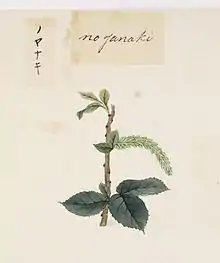| Salix subopposita | |
|---|---|
 | |
| Drawing of a Salix subopposita | |
| Scientific classification | |
| Kingdom: | Plantae |
| Clade: | Tracheophytes |
| Clade: | Angiosperms |
| Clade: | Eudicots |
| Clade: | Rosids |
| Order: | Malpighiales |
| Family: | Salicaceae |
| Genus: | Salix |
| Species: | S. subopposita |
| Binomial name | |
| Salix subopposita | |
Salix subopposita (Japanese: ノヤナギ, romanized: Noyanagi), also known as the opposite-leaved willow, is a species of willow native to southern Japan and Jeju Island in South Korea.[1][2] It is a deciduous small shrub with a maximum height of 0.5 meters.
References
- ↑ "Salix subopposita | opposite-leaved willow Shrubs/RHS Gardening". www.rhs.org.uk. Retrieved 2022-09-20.
- ↑ "Salix subopposita Miq. | Plants of the World Online | Kew Science". Plants of the World Online. Retrieved 2022-09-20.
This article is issued from Wikipedia. The text is licensed under Creative Commons - Attribution - Sharealike. Additional terms may apply for the media files.